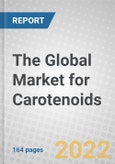The global market for carotenoids is estimated to increase from $2.1 billion in 2024 to reach $2.9 billion by 2029, at a compound annual growth rate (CAGR) of 6.7% from 2024 through 2029.
Europe led the carotenoid market in 2023, driven by growing demand for natural and clean colorants in food and beverage products. The market is predicted to rise at a CAGR of 6.1% through 2029.
Carotenoids are naturally occurring color pigments widely used in food, beverages, animal feed, pharmaceutical, nutraceutical, dietary supplements and cosmetic industries. They are produced naturally from plants, algae, bacteria, yeast and mold or synthetically from chemicals.
Carotenoids are increasingly used to produce various health supplements, such as beta-carotene, which is used to make vitamin A. The rising demand for dietary supplements globally drives the demand for carotenoids. Increasing animal feed consumption in developing regions like India, Brazil and South Africa is expected to drive the demand for carotenoids throughout the forecast period. Additionally, growing consumer awareness of health, wellness and environmental impact fuels the demand for carotenoids, supporting market growth.
Report Scope
This report provides market projections for the global carotenoids market from 2024 through 2029. It also analyzes the market shares of leading companies. Based on source, the carotenoids market is segmented into synthetic and natural. Based on product, the market is segmented into astaxanthin, beta carotene, lutein, lycopene, canthaxanthin and others. It is further segmented by application into food and beverages, dietary supplements, feed and others. Regional estimates and forecasts include North America, Europe, Asia-Pacific, South America and the rest of the world.
Report Includes
- 45 data tables and 42 additional tables
- An up-to-date review and analysis of the global market for carotenoids
- Analyses of the global market trends, with sales data for 2023, estimates for 2024, and projections of compound annual growth rates (CAGRs) through 2029
- Evaluation and forecast the overall market size for carotenoids and their corresponding market share analysis by product, source, application, and region
- Coverage of commercial carotenoids with detailed insight into production technologies, market developments and market dynamics
- Information on Annatto, Astaxanthin, Beta-carotene, Beta-apo-8-carotenal, Beta-apo-8-carotenal-ester, Canthaxanthin, Capsanthin and paprika extract, Lutein, Lycopene and Zeaxanthin, and coverage of their production process, regulatory framework, and applications
- Highlights of the market potential for carotenoids, and areas of focus to forecast this market into various segments and sub-segments
- In-depth information (facts and figures) concerning market drivers, opportunities, challenges and other demographic and economic factors that will drive future demand for this market
- Review of the current market status, key technology issues, industry value chain, Porter’s five forces analysis, competitive scenario, R&D activities, and COVID-19 implications on the progress of this market
- A discussion on ESG challenges and practices of the industry
- Market share analysis of the key companies of the industry and coverage of their proprietary technologies, strategic alliances, and other key market strategies
- Company profiles of major players within the industry, including BASF, DSM Firmenich, Divi's Laboratories Ltd., and Givaudan
Table of Contents
Executive Summary
Carotenoids are isoprenoid pigments used extensively in the culinary, chemical, textile, pharmaceutical and cosmetic industries. They are not only dyes and provitamin A, but they are also antioxidants, photoprotective and antibacterial. This type of pigment can be produced historically from plants or through chemical synthesis, but it has various disadvantages. The carotenoid industries have prioritized the search for alternative sources in recent years. Microbial synthesis is a viable solution with high yields, speed, and low production costs. Because of the oxidative stress caused by sunshine, unfavorable environments, such as the Caatinga domain, are an appealing source of bacteria that produce biomolecules, particularly carotenoids.The majority of commercialized carotenoids are derived via vegetable extraction and chemical synthesis. Seasonal and geographical fluctuation, for example, are uncontrollable issues in the manufacture and sale of these colors. Chemical synthesis, on the other hand, is a generally complex process that results in the development of dangerous and inappropriate waste when disposed of in the environment; also, this is not regarded safe for health. This causes widespread anxiety, which reverberates in several conversations regarding the unintended consequences of these synthetic pigments and their potential repercussions on human health. As a result, the synthesis of carotenoids by microbes is a realistic technique that fits the safety marketing appeal while also allowing for the rapid and efficient production of these natural colors on an industrial scale.
Companies Mentioned
- ALLIED BIOTECH CORP.
- BASF
- BIOEXTRACT
- CYANOTECH CORP.
- DIVI'S LABORATORIES LTD.
- DӦHLER GMBH
- DSM-FIRMENICH
- E.I.D. - PARRY (INDIA) LTD.
- EW NUTRITION
- FARBEST BRANDS
- GIVAUDAN
- KEMIN INDUSTRIES INC.
- LYCORED
- NHU ZHEJIANG
- SENSIENT TECHNOLOGIES CORP.
Table Information
| Report Attribute | Details |
|---|---|
| No. of Pages | 105 |
| Published | March 2025 |
| Forecast Period | 2024 - 2029 |
| Estimated Market Value ( USD | $ 2.1 Billion |
| Forecasted Market Value ( USD | $ 2.9 Billion |
| Compound Annual Growth Rate | 6.7% |
| Regions Covered | Global |
| No. of Companies Mentioned | 15 |









